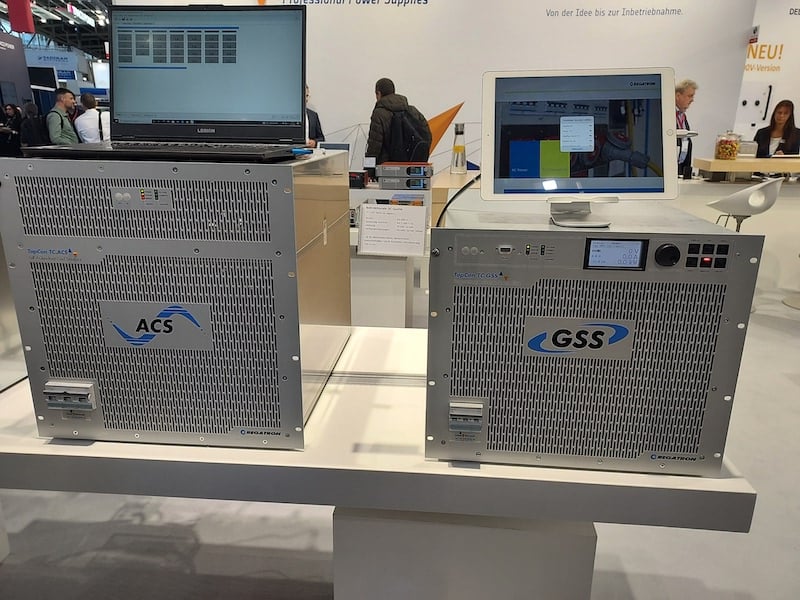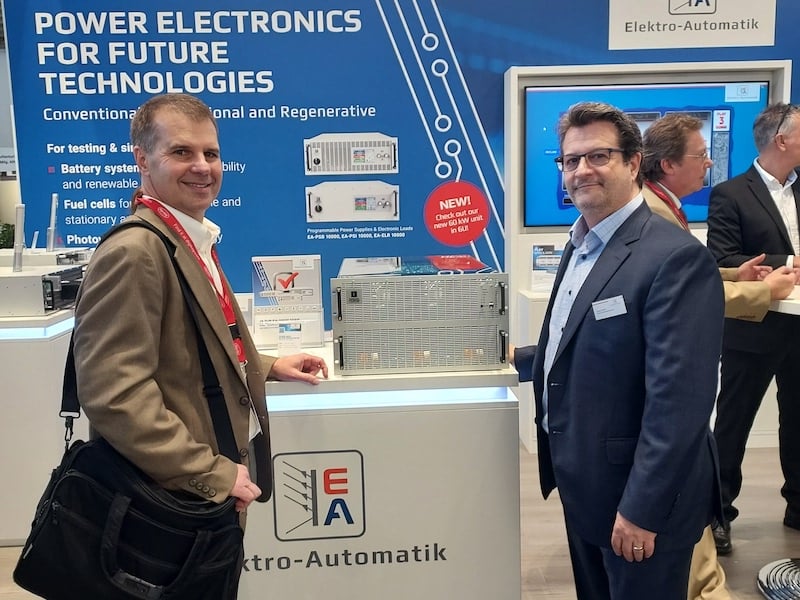Regenerative Power Supplies Create Lots of Energy at Electronica
With energy costs increasing, bi-directional power supplies are providing a cost-effective solution for testing and hardware simulation for the latest renewable energy technologies.
The EE Power team was on-site in Munich, Germany, for the electronica 2022 conference and trade show, where many companies highlighted their latest advancements in regenerative (bi-directional) power supplies. We talked to representatives and saw product demonstrations from AMETEK, EA Elektro-Automatik, Pacific Power, and Regatron.
Regatron TC.ACS 50-kVA four-quadrant bi-directional AC power supply (left) and TC.GSS two-quadrant DC power supply (right). Image used courtesy of Dale Wilson
Why Bi-directional?
Regenerative power supplies and loads can pass power bi-directionally—both to and from the AC utility grid and a device under test. You may also hear these power supplies referred to as bi-directional. This ability to recover electric energy during testing and return it to the grid is a relatively new feature of high-power supplies, but it is becoming increasingly important as a means to save power and costs during product development and production testing.
Application of regenerative bi-directional supplies. Image used courtesy of EA Elektro-Automatik
Let’s take end-of-life testing of electric vehicle (EV) batteries as an example. These need to be charged and discharged to determine if they could be repurposed for other, less-demanding applications than automobiles. During the discharge phase of the testing, regenerative power supplies and loads can return that energy to the grid at efficiencies of up to 96 percent. This provides immediate economic benefits.
Joshua Parsley, regional sales manager of PPST Solutions, gave the example of testing a 300-kilowatt (kW) application where 90 percent of that power is stored in the batteries. If you can return that power to the grid, you have saved 270 kW.
A secondary benefit is that the power that is returned to the grid is not released as heat. This reduces the cooling requirements for the building hosting the test system, thereby providing additional energy and cost savings. With test systems operating up into the megawatt (MW) range, high-efficiency, bi-directional power supplies are becoming increasingly important. Many people at electronica mentioned that electricity costs have tripled in Europe.
Silicon Carbide Drives Power Supply Technology Advances
Silicon carbide (SiC) technology was displayed all across the electronica 2022 show floor, from wafers and transistors to those embedded in these high-power regenerative supplies and loads. As we talked to these suppliers, it was evident that SiC enabled many of the new products and features on display.
The efficiency of SiC enables ever-higher power densities in smaller form factors. Reduced losses mean less heat generation, and higher switching frequencies allow smaller components, particularly the magnetics.
Leonard Kathan, field application engineer for Regatron, described how SiC was allowing them to improve the dynamic response of their power supplies. The newer models with SiC can change the voltage and current in less than 200 μs, as opposed to more than 1 ms for their older power supplies.
EA Elektro-Automatik Announces Two Bi-directional Products
At the show, EA Elektro-Automatik announced two new bi-directional power products: the EA-PUB 10000 Programmable Bidirectional DC Power Supplies and the EA-PUL DC Programmable Regenerative Electronic Loads. These products come in 30- and 60-kW versions, with more than 20 unique models available at each power level. The 60-kW models are in a compact 6U enclosure and provide maximum voltages of 360 to 2,000 volts and maximum currents of 480 to 80 amperes.
Elektro-Automatik 60-kW 6U bi-directional power supply demonstrated at electronica 2022. Image used courtesy of Dale Wilson
Demonstrating these new products on the day of the announcement, Craig Frahm, global marketing manager, told EE Power, “What's interesting about these is that they are made for industrial applications because, as you can see, it has no knobs or our typical HMI touchscreen display.”
With five of these able to fit into a standard rack, “You can crank out as much as 300 kW in one rack,” he said. And, with an ability to parallel up to 64 of the 60-kW units, it is possible to generate almost 4 MW.
Regatron Four-quadrant Bi-directional AC Power Supplies
Kathan demonstrated a 50-kilovolt-amp (kVA) model from Regatron’s TC.ACS series of four-quadrant three-phase AC power sources. A four-quadrant supply can provide positive and negative voltages while sourcing or sinking current. The 50-kVA model can be connected in parallel to reach powers up to 2.4 megavolt-amps (MVA).
A programmable RLC-load mode can substitute for bulky resistors, inductors, and capacitors. And instead of wasting that power, it can be returned to the three-phase grid at high efficiency.
Sneak Peak of Pacific Power Source AGX Series of Regenerative Supplies
While not officially launched yet, a new series of AGX regenerative supplies from Pacific Power Source was on display in the PPST Solutions booth. Parsley explained that the AGX series is a regenerative series derived from the AFX series.
A 15-kVA model was displayed, but Parsley mentioned that 18 -kVA models will also be available. The AGX are single-phase, split-phase, and three-phase, AC, DC, and AC plus DC output capable power supplies. Initial versions of the AGX are planned to support frequencies up to 1,200 Hz, with extended models likely to support frequencies as high as 3,000 Hz.
Applications for Bi-directional Power Supplies and Loads
When asked who needs these high powers, Craig Frahm mentioned the companies working in the fuel cell industry. Electro-Automatik sees “early adoption in these manufacturing facilities to distill hydrogen.” Other high-demand applications include EV battery pack testing and photovoltaic (PV) solar inverter testing.
Dan Donati, Vice President of Strategic Product Management at AMETEK Programmable Power, also mentioned complex fuel cell simulations as an impactful application of these newer regenerative supplies:
You've got pressure, temperature, and flow. You have all of these things in this electromechanical thing connected to the actual fuel cell. The people who design the control systems software are trying to make sure they can control the system safely, and you have to test that control system on use cases that are realistic.
Programmable bi-directional power supplies allow these complex simulations to be completed safely.
Many of these bi-directional supplies support complex function generation. The newly released EA Electro-Automatik products have an onboard function generator that allows users to create complex voltage waveforms for simulating solar cells, batteries, and fuel cells. Special functions enable maximum power point tracking (MPPT), EN 50530 solar panel inverter testing, and standards-based testing of automotive components and systems.
With increasing energy costs comes more demand for reduced waste. Bi-directional, regenerative power supplies are stepping up to the challenge by providing high-performance test capabilities and advanced energy recovery capabilities.
Sadly, we can’t cover all of the amazing and even fun technology demonstrations from this year’s electronica conference. But I will leave you with this demonstration from Ametek of controlling a high-voltage supply to drive a heating element and fan to make popcorn. Temperature sensors monitored the heat at multiple points, and a high-speed camera captured the dynamics of the kernels popping.










